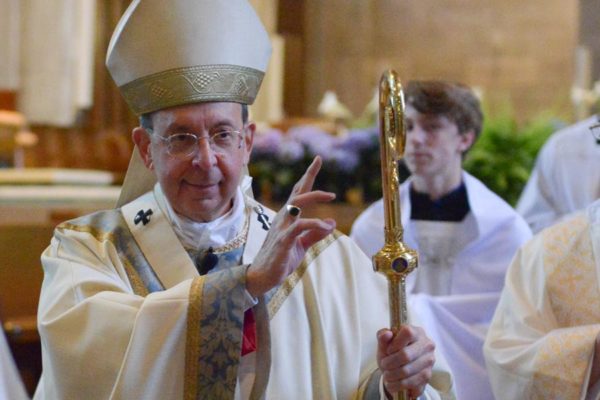Mass for the Sulpician General Council
St. Charles Chapel; Catonsville, MD
July 24, 2017
It is a pleasure to welcome you, the leadership of the Society of San Sulpice, to the Archdiocese of Baltimore – thank you for meeting here at St. Mary’s. As you know, the Society and the Archdiocese share a long and storied history. The arrival of the Sulpicians in Baltimore was truly a providential event not only for the newly founded See of Baltimore but indeed for the future of the Church in a new republic.
I am reminded of this legacy constantly –not only when I visit Paca Street or St. Charles or St. Mary’s in Roland Park, but indeed in my residence and in the Basilica Cathedral to which it is attached. The Basilica of the Assumption was begun by Archbishop John Carroll in 1806 but it was the 3rd Archbishop of Baltimore, Archbishop Ambrose Maréchal – himself a Sulpician – who completed its construction and who, in large part, built my residence which serves also as the basilica rectory. Inscribed on the high altar of the Basilica are the initials “AM” which mean, of course, “Auspice Maria” – but they could also mean “Ambrose Maréchal”! In my residence hangs a beautiful portrait of the 3rd Archbishop of Baltimore together with a large cache of monumental paintings which Archbishop Maréchel allegedly coaxed from his friend, Cardinal Fesch – the erstwhile Archbishop of Lyon and uncle of Napoleon Bonaparte.
Yet, all these reminders are more than mere souvenirs of bygone times. Rather, they lead me to a much deeper reality – namely – the work of the Society in forming priests for a new millennium – for a period of time dubbed by Pope Francis not merely as “an era of change but the change of an era.” As society and culture undergo profound and rapid changes on many fronts, history itself seems to rush forward at an accelerated pace. Thus a Church that is “semper reformanda” always is confronted with fresh challenges and opportunities.
More than 50 years ago, the II Vatican Council reiterated the call of the Savior in the Gospels to read the signs of the times. In Matthew 16:3, Jesus chastises the Pharisees and Scribes telling them that they can interpret the portents of the weather but cannot read the signs of the times. So too Gaudium et Spes, echoing the words of St. John XXIII, summoned us to “read the signs of the times in the light of the Gospel” (GS, 4).
After all, a Church which does not listen and learn will not be well equipped to preach and teach. A Church which does not take seriously the culture in which it evangelizes will be scarcely able to purify and transform that culture from within. If parishes are not to become irrelevant, they will need to be led by priests who are neither whistleblowers nor bellwethers; rather, they will need to be led by pastors whose hearts are strong, loving, and wise, pastors with discerning, faithful, and merciful hearts, pastors with passionate love especially for the poor and vulnerable. Such priests raise up good co-workers from among the laity and inspire them to go forth and bring the Gospel outward. Such priests know how to teach, sanctify, and lead — effectively and lovingly.
In these times of profound and rapid change, it is all-too-easy to feel that we are lost amid the uncharted waters all around us. This is especially true for an aging baby-boomer like myself. Yet it falls to us to help new generations of priests to find the North Star – the sign that endures from age to age and from generation to generation – to guide them in their journeys both personal and pastoral.
Those signs shine forth in today’s liturgy – in the Book of Exodus which recounts the deliverance of God’s people from slavery and reaffirms the fundamental truth of God’s presence in history; and in the Gospel of Matthew where Jesus tells those who are looking for signs and wonders that the only sign they will receive is the sign of Jonah – that is to say, the sign of Jesus’ death, burial, and resurrection. This sign, the Pasch, is the North Star, the guiding light, the Gospel which sheds its light on these times no less than on times past. And it is under this sign that we must form the future priests of the Church. A Charism from the Past for the Future
The Society of San Sulpice is blessed with a living charism and heritage well-suited for the times that are unfolding before us. Father Olier bequeathed to you and to the whole Church a beautiful vision of priestly formation & spirituality, as relevant today as it was then. Yes, it may have to be retooled, retrofitted, and re-translated for a new age yet its essential lines and insights will help present and future generations of priests to hold fast to the sign of Jonah, the Paschal Mystery – and to proclaim that mystery, to re-present it, and to live it.
I am grateful for all you are doing to deepen your appreciation of this heritage and know that in the present Archbishop of Baltimore the French School of Spirituality has a devotee. I also ardently support and promote the mission of St. Mary’s Seminary, confident in the priestly formation it is providing future priests, grateful for the ways it enriches the laity theologically and ministerially, hopeful in the deepening of ecumenical and interreligious ties it fosters.
May the Lord bless you, the leadership of the Society of San Sulpice, during your days here in the Archdiocese of Baltimore so that you may read ever more perceptively ‘the signs of the times in the light of the Gospel.’


